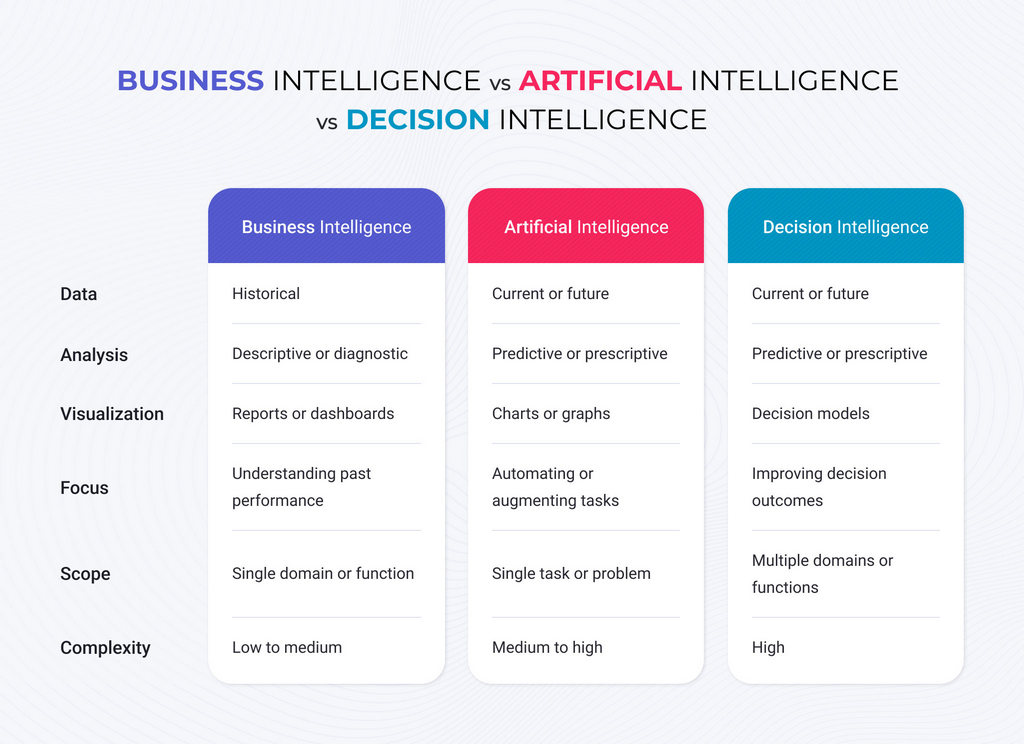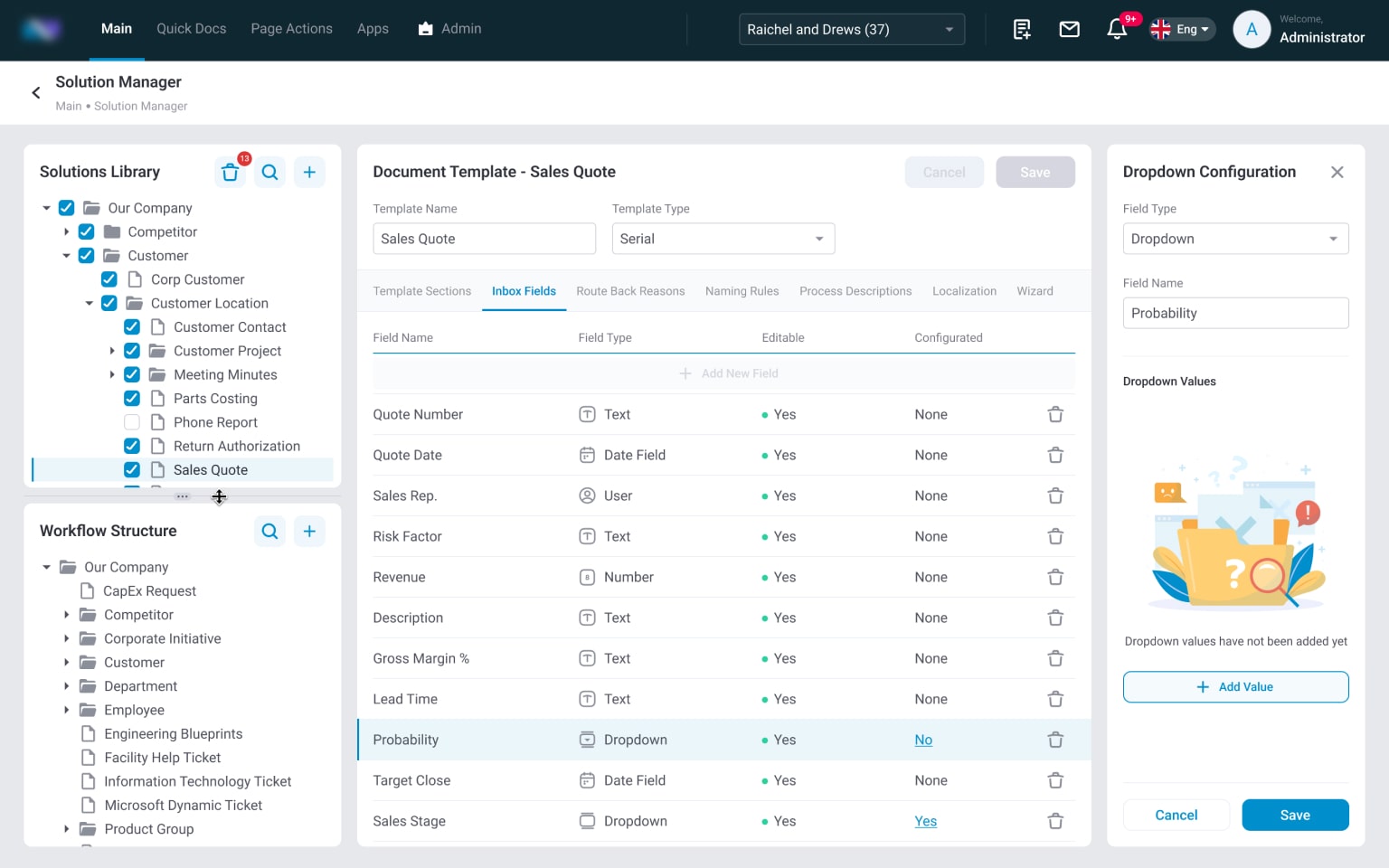Summary
The article defines Decision Intelligence (DI) as a modern discipline that combines BI, AI, and decision-management techniques to help businesses make smarter, faster choices by modeling cause-and-effect relationships and simulating outcomes. It shows how DI goes beyond traditional dashboards by enabling decision modeling, feedback loops, and prescriptive analytics — all while helping organizations act with more agility and reduce risk.
Times change, and businesses invent new approaches or transform current ones to keep up with the technological breakthroughs happening almost every month now. Considering how much data businesses need to deal with on a daily basis, decision-making becomes more difficult, and common Business Intelligence (BI) practices may not be enough.
In the era of digital transformation, data is the new oil that fuels business growth and innovation. However, data alone is not enough to make smart and effective decisions. Businesses need to leverage the power of Artificial Intelligence (AI) and BI to analyze, understand, and act on data. But what if there is a way to combine the best of both worlds and create a new discipline that can improve decision-making processes and outcomes? This is where Decision Intelligence (DI) comes in.
According to MarketsandMarkets analysis, the global decision intelligence market size is predicted to reach $22.7 billion by 2027, increasing at a CAGR of 17.8% from 2022 to 2027. Therefore, let’s explore what it is, how it differs from BI and AI, what benefits and challenges it has, and which tools and technologies can enable it.
What Is DI and How Does It Help with Business Processes?
Decision Intelligence is a practical domain that frames a wide range of decision-making techniques. It brings multiple traditional and advanced disciplines together, including decision management, decision support, as well as descriptive, diagnostics, and predictive analytics. This vastness of tools helps companies with the design, execution, monitoring, and tuning of decision models and processes.
It is a trending field that combines data science, AI, and BI to help organizations make better and more accurate decisions. DI uses data and predictive models to create a chain of cause and effect that links actions to outcomes. Due to its versatility, this approach can be basically applied to any industry, such as supply chain, marketing, finance, healthcare, education, etc. It becomes especially popular among enterprises.
DI enhances decision-making by analyzing and designing how decisions are made and how outcomes are assessed, managed, and improved by feedback. Using Artificial Intelligence solutions, decision intelligence harnesses the power of entity resolution and graph analytics to transform data into accurate decisions at scale. It means that data becomes more than the sum of its parts – not fragmented, isolated, and affected by poor quality. DI connects all data from previously separated and dispersed sources, and creates a single trusted and reusable resource.
Read Also How Data Intelligence and Data Analytics Differ From BI and BA and Why They Matter
How Does DI Differ from BI and AI?
To dive deeper into the unique aspects of DI, we need to understand the basics and know the ins and outs of its predecessors. Therefore, let’s explore not only decision intelligence but also BI and AI.

To start with the roots, we need to look at business intelligence first, because it is what has been used by businesses for a really long time. BI is a set of processes, technologies, and tools that collect, store, analyze, and present data to support business decision-making. It typically uses historical data from various sources, which include databases, data warehouses, and data lakes and follows descriptive or diagnostic analysis. Whether it is used by specialists from sales, marketing, or finance and operations departments, BI methods help businesses to understand what happened in the past, why it happened, and what can be done to improve performance.
If talking about artificial intelligence, it is a branch of computer science that aims to create machines or systems, which are able to perform tasks that normally require human intelligence. AI typically uses algorithms or models that learn from data or experience to perform recognition, classification, prediction, optimization, or generation operations. In simple words, it follows predictive or prescriptive analysis. It is a great tool that works with current or future data for successful automation of tasks, augmentation of human capabilities, and creation of new products or services.
Read Also How Adaptive AI Takes the Interaction Between Business and Customers to a New Level
As for decision intelligence, this discipline combines BI and AI to improve decision-making processes and outcomes. Just like artificial intelligence, it works with current or future data. DI helps businesses to understand which actions lead to which outcomes, which of them are the best, which scenarios can be chosen, and how to monitor and adjust actions based on feedback. In case of analysis, DI again copies the AI approach and follows predictive or prescriptive analysis. While BI and AI use reports, dashboards, charts, and graphs for data visualization, DI uses decision models.
Decision modeling is the process of creating a visual representation of a decision situation using a formal language or notation. It can involve decision tables, decision trees, decision graphs, influence diagrams, or other forms of decision modeling. The common decision models include the following:
- Rational model. This is the decision-making model that prioritizes logic and analysis. The process is strict and precise: you need to clarify the goal, determine decision criteria and define the relative importance of each of them, seek possible alternatives and gather information on them, determine the best alternative, and then execute and evaluate the decision.
- Intuitive model. It is the opposite of the rational approach, which means that you make your decisions based on what feels right to you. It can be a good option when you have a lot of knowledge of the subject to trust your gut feeling.
- Recognition-primed model. The model focuses on the intuitive decision-making process of people in high-pressure professions (for example, firefighting, nursing, the military, etc.) who have to make quick decisions that can lead to saving lifes. It can be considered as an intuitive model that can be transformed in the process depending on the situation.
- Creative model. The creative decision-making model is ideal when you need to think outside the box and create something new. It includes a lot of brainstorming in the process and deep analysis of the problem and available options.
- Vroom-Yetton decision model. In most cases, businesses choose this model when they don’t know which one to follow from the list of options. It formulates seven critical questions, associated with quality, commitment, problem structure, leader’s information, goal congruence, and subordinate conflict, to create a decision tree and let leaders make the right choice.
Which Tools and Technologies Enable DI?
To ensure that your company has to deal with fewer challenges and issues and that decision intelligence suits your business strategy, it is essential to know a combination of tools and technologies that can support the different aspects of decision-making processes. Some of those tools and processes include the following:
- Data sources. These are the systems or platforms that provide the data for decision intelligence, which are basically the core of the whole process. They can include databases, data warehouses, data lakes, data streams, APIs, web services, or sensors. Working with data sources and combining data into a unified format involves different operations, such as data extraction, transformation, loading (ETL), data governance, and more.
- Decision management. This is the process of automating or orchestrating the execution of decisions using rules, events, workflows, or agents. It can involve business rules management systems (BRMS), complex event processing (CEP), business process management (BPM) software, or agent-based systems (ABS).

Source: Workflow Automation Software
- Data visualization. People absorb information better when it’s visualized, and DI also involves the process of presenting data. When data is shown in a graphical or interactive way, you better understand it to share it with other stakeholders. Data visualization can involve reports, dashboards, charts, graphs, maps, and other tools of data visualization.
- Data analysis. It is impossible to omit the process of applying statistical or mathematical techniques to data to discover patterns, trends, insights, or predictions. Also, you should not forget that data analysis can involve descriptive analytics, diagnostic analytics, predictive analytics, or prescriptive analytics to know how DI can predict the outcome.
- Decision support. This is the process of providing guidance or recommendations to human decision-makers using data, models, or simulations. It can involve decision support systems (DSS), expert systems (ES), simulation systems (SS), or optimization systems (OS).
Read Also 7 BPM Trends You Should Start Using Today
What Are the Benefits and Challenges of DI?
As you can see, DI took the best from BI and AI to bring business intelligence tools and practices on another level and make them modern and trendy. But, is the new approach really so beneficial for companies? Let’s look at the advantages of DI and the challenges that a business can run into while following this discipline to understand it better.
Decision intelligence can provide various benefits for businesses by changing different sides of decision-making:
- Improves quality and speed by reducing uncertainty, bias, and errors;
- Enhances collaboration and alignment by providing a common language and framework for decision-making;
- Increases agility and adaptability by enabling rapid experimentation, learning, and feedback;
- Optimizes performance and efficiency by using data and models to find the best actions and trade-offs;
- Supports innovation and transformation by discovering new opportunities and scenarios.
Covering possible challenges that DI could bring is also important, so let’s see which key issues your business can face:
- Incomplete or outdated data. Decision intelligence requires reliable, relevant, and timely data to feed the AI tools and models. That is why before choosing DI as your main approach, you need to get rid of inaccurate and inconsistent data, because it will affect the validity and reliability of the results;
- Model complexity. DI relies on sophisticated models that can capture the complexity and uncertainty of the decision situations. However, these models can be difficult to understand, especially for non-expert users or stakeholders that don’t deal with them on a daily basis. So, be sure that the data is not only up-to-date but is also analyzed by experts.
Read Also How to Overcome Common Challenges in Data Engineering to Make Data Work for You With Minimum Effort
Conclusions
Decision intelligence is a relatively new discipline that combines best practices from the past and present trends by joining BI and AI solutions together to keep with the modern times. DI can benefit different types of businesses that have complex or uncertain decision situations. So, it may be a good idea to upgrade your current business intelligence tools to meet the new future. If you want to know how else you can improve your business processes and which system can be a game-changer in your case, please contact us. We will be glad to hear out your ideas and share our insights on them.